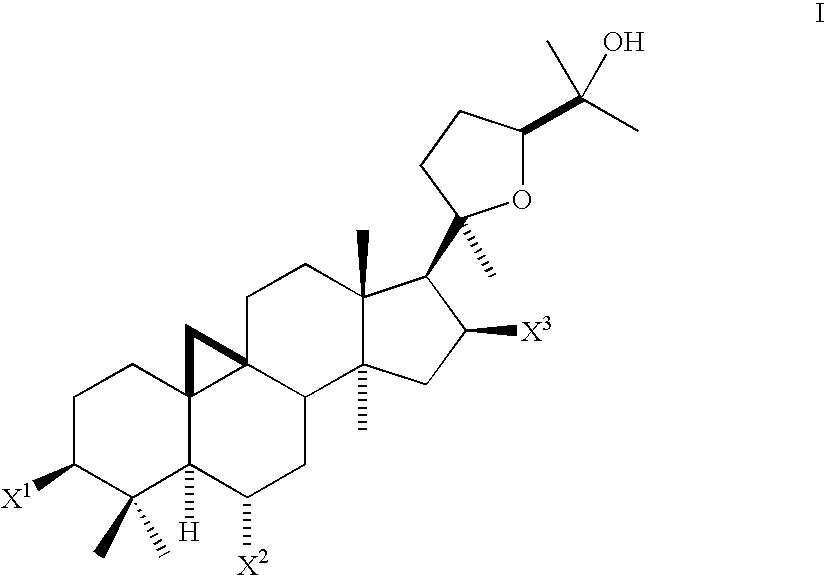Compositions and Methods for Increasing Telomerase Activity
a technology of telomerase activity and composition, which is applied in the field of compositions for increasing telomerase activity in cells, can solve the problems of limited bioavailability of naturally occurring compounds described therein including cycloastragenol, and compounds previously described were very much less effective, so as to increase telomerase activity, increase telomerase activity, and increase telomerase activity
- Summary
- Abstract
- Description
- Claims
- Application Information
AI Technical Summary
Benefits of technology
Problems solved by technology
Method used
Image
Examples
example 1
Conversion of astragaloside IV (1) to 17-[5-(1-Hydroxy-1-methyl-ethyl)-2-methyl-tetrahydro-furan-2-yl]-4,4,13,14-tetramethyl-tetradecahydro-cyclopropa[9,10]cyclopenta[a]phenanthrene-3β,6α,16β-triol[cycloastragenol] (2)
[0150]
[0151]To astragaloside IV (1) (5.00 g, mmol) was added “HCl-MeOH 10” (TCI America) (500 mL) and the mixture was stirred at room temperature for 7 days. The reaction mixture was concentrated to about half volume under reduced pressure at 20° C. (do not heat). The mixture was partitioned into aqueous sodium bicarbonate and ethyl acetate. The aqueous layer was extracted with ethyl acetate again. The organic layers were combined, washed with saturated sodium chloride, dried on anhydrous sodium sulfate, and concentrated under reduced pressure. The residue was purified by column chromatography (20:1˜14:1 chloroform / methanol). In order to replace the residual solvent with ethanol, the purified material was dissolved in ethanol and the solvent was removed under reduced p...
example 2
Preparation of 2-(L)-Amino-3-methyl-butyric acid 6α,16β-dihydroxy-17-[5-(1-hydroxy-1-methyl-ethyl)-2-methyl-tetrahydro-furan-2-yl]-4,4,13,14-tetramethyl-tetradecahydro-cyclopropa[9,10]cyclopenta[a]phenanthren-3β-yl ester. hydrochloride salt [C3-(L)-valyl-cycloastragenol] (4)
[0153]
[0154]Preparation of 3: Boc-(L)-Valine-OH (18 g, 81.63 mmols) (Bachem, Torrance, Calif.) was dissolved in 150 ml of dichloromethane (DCM). To this was added 15 g (81.63 mmol) of pentafluorophenol. The reaction was cooled in an ice-bath followed by slow addition of 12.8 ml (81.63 mmols) of 1,3 diisopropylcarbodiimide (DIC). After complete addition the reaction mixture was stirred at room temperature for 30 minutes at which time the reaction mixture turned turbid (diisopropylcarbodimide-urea precipitation). To this mixture was then added 10 g (20.41 mmols) of (2) followed by 10 g (81.63 mmol) of dimethylaminopyridine (DMAP) and the reaction was stirred at room temperature for 24 hours. The reaction mixture wa...
example 3
Preparation of 2-(D)-Amino-3butyric acid 6α,16β-dihydroxy-17-[5-(1-hydroxy-1-methyl-ethyl)-2-methyl-tetrahydro-furan-2-yl]-4,4,13,14-tetramethyl-tetradecahydro-cyclopropa[9,10]cyclopenta[a]phenanthren-3β-yl ester, hydrochloride salt hydrochloride salt [C3-(D)-valyl-cycloastragenol] (5)
[0158]
[0159]Using the procedure of Example 2 with Boc-(D) Valine-OH (Bachem, Torrance, Calif.) (18 g, 81.63 mmols) compound 5 was prepared.
[0160]1HNMR for 5 (DMSOd6) δ ppm: 0.30 (bs, 1H), 0.50 (bs, 1H), 0.80-1.39 (m, 29H), 1.46-1.58 (m, 3H), 1.61-1.70 (m, 2H), 1.79-1.89 (m, 4H), 2.16-2.32 (m, 2H), 2.38-2.54 (m, 2H), 3.29-3.41 (m, 2H), 3.58-3.61 (t, 1H), 3.81-3.83 (m, 1H), 4.13-4.24 (bs, 4H), 4.50-4.52 (q, 2H), 4.54-4.59 (m, 1H), 8.43-8.60 (bs, 2H). MS (M+H) 590.
PUM
 Login to View More
Login to View More Abstract
Description
Claims
Application Information
 Login to View More
Login to View More - R&D
- Intellectual Property
- Life Sciences
- Materials
- Tech Scout
- Unparalleled Data Quality
- Higher Quality Content
- 60% Fewer Hallucinations
Browse by: Latest US Patents, China's latest patents, Technical Efficacy Thesaurus, Application Domain, Technology Topic, Popular Technical Reports.
© 2025 PatSnap. All rights reserved.Legal|Privacy policy|Modern Slavery Act Transparency Statement|Sitemap|About US| Contact US: help@patsnap.com



